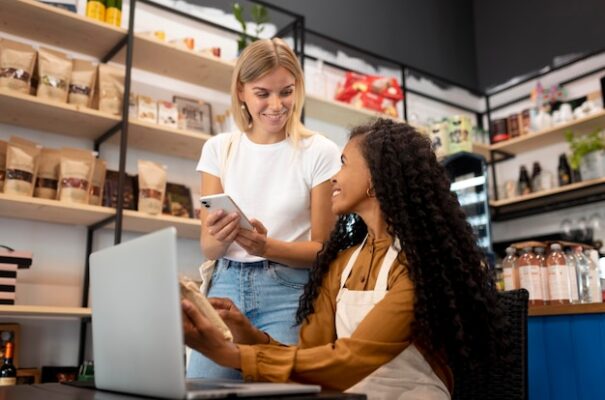
by Jeff Hastings
In this article, we will discuss how a small shop can compete with large retail chains. We’ll look at the main differences between big box retailers and cozy local shops, and show you how to stand out from the giants and attract your customers.
What is a Big Box Retailer: Definition
A Big Box Retailer is a large retail chain with huge stores offering a wide range of goods at low prices. These are usually national or international companies aimed at the mass buyer. Imagine the hypermarkets you see in big cities: this is a prime example of a big box retailer.
Big Box Retailer Examples
In the US, the most prominent representatives of big box retail are giants like Walmart. It is a true king of the trade, offering almost everything from food to clothing and electronics. Their main weapon is low prices and a wide selection of goods, which attracts a huge number of customers.
Another well-known example is Target. Unlike Walmart, Target positions itself as a more stylish and fashionable store, offering higher-priced goods, but still focuses on the mass consumer. They focus on design and quality, which attracts a different audience compared with Walmart.
Finally, Costco is a club network that operates on the principle of wholesale sales. For club members, they offer a huge selection of goods at discounted prices due to large purchase volumes. This is convenient for those who buy a lot of goods at once, for example, for home or business.
What Is a Small Local Retailers
Small box retailers are small stores, often family-owned or individually operated, that focus on a specific niche or local market. Unlike large retail chains, they offer a more personalized approach to customer service and often specialize in unique products or services that you won’t find in large hypermarkets. These can be, for example, specialized handicraft shops, designer clothing boutiques, or cozy bookstores.
Also: A One-Stop-Shop Marketplace for Local Retailers
Small Box Retail Examples
Unfortunately, it is difficult to give specific examples of small American retailers because their number is huge, and they differ a lot depending on the region and specialization. Instead of listing specific names, let’s look at some typical examples.
Imagine a small, family-owned clothing store in a quiet town. They offer unique designs that are hard to find in large chains, and owners often know their customers in person, making the service very friendly and personal.
Another example is a specialized coffee shop. They don’t just sell coffee, they create a whole atmosphere by offering different sorts of coffee, tea, desserts, and a cozy seating area. Such a store focuses on the quality of their product and the atmosphere, thus creating customer loyalty.
Finally, think of a small bookstore with rare editions. It has its own special charm that keeps people coming back not just for books, but for the atmosphere and socializing. These are examples of businesses that become part of the local culture.
Big-Box Stores Vs. Small Retailers
Let’s compare shopping in large warehouse stores like BJ’s, Costco, and Sam’s Club with small local shops. Here are the main pros and cons:
Advantages:
- significantly lower prices due to wholesale purchases and large sales volumes;
- a wide range of products, that is often not typical for small stores;
- the ability to purchase goods in large quantities, which is beneficial for families and businesses;
- convenient location, often large parking lots.
Disadvantages:
- the need to pay membership fees;
- large volumes of purchases are not always convenient for those who buy little;
- possible problems with parking during peak hours;
- less emphasis on personalized customer service;
- limited selection of some product categories.
Also: Does Buying Local Have A Positive Impact on the Planet
How Small Retailers Can Stay Competitive
Since the emergence of large shopping centers such as Walmart in 1962, small businesses have been constantly facing the challenges of competition.
For example, on Chicago’s West Side, 82 local stores closed after Walmart had opened in 2006. The promises of large chain in terms of economic growth and job creation were not realized – instead, there was a drop in economic activity and the loss of approximately 300 retail jobs in neighboring areas.
The situation has gradually changed, but big box retailers are still serious competitors for small businesses.
Use Your Local Niche
One of the main differences between large retail chains and small local stores is the business model. Large chains are required to order huge quantities of goods in order to be a one-stop shop for everyone. This often leads to the sale of inexpensive, mass market goods manufactured abroad and leaves little room for unique, local products.
Small stores can capitalize on this by offering customers something special that big supermarkets don’t have. Cooperation with local producers allows you to create unique products in small batches.
The exclusive right to sell a line of original products is a great way to attract loyal customers who value exclusivity.
E-Commerce Is a Key Success Factor
Online activity is a key component of success in modern retail. Consumers expect a convenient online shopping experience that is optimized for any gadget.
The easier it is for customers to access your products, the higher the chances of increasing your customer base and repeat purchases. Even a small store should have a well-designed and user-friendly website that is optimized for mobile browsing and shopping.
Great platforms for this are Squarespace or Shopify. The website should contain high-quality images, company and brand information, a convenient way to contact, and information about the physical location of the store. What strategies can small business owners use to compete with large retailers?
Activity in Social Networks
In addition to a website, social media presence became an integral part of success. You should plan your social media posts and overall strategy as carefully as you would merchandising in your store. Your online image should be consistent with your offline presence. Engage customers by creating interesting content, encouraging photos, and sharing reviews on social media. The goal of this strategy is to encourage customers to share their positive experiences with friends.
Service Is a Key Factor
Apart from products and merchandising, service plays an important role. For big box businesses and small companies, insensitive communication and complicated return procedures can result in failure. A clear return and exchange policy, friendly and attentive service is what distinguishes a successful business.
Memorable Merchandising
Large stores often use the same design in all their locations. Smaller stores have more freedom to be creative. Using original displays, regularly updating displays, and using unique decorations help to emphasize individuality.
Find the Right Partners
To keep merchandising relevant, find an experienced partner who understands the needs and budget of a small business. The partner should help define your vision and create storefronts and design elements to meet your requirements. This will help your unique business glow.
To summarize, the success of small businesses in competing with large retail chains depends on a clear understanding of their own niche, an active online presence, and a high level of customer service. Creating a unique brand and memorable merchandising is the key to attracting and retaining customers.
By the way, Wholesale Central is your trusted source for finding high-quality merchandise at the best prices to stock your store. Sign up today and gain access to a wide range of suppliers and products to ensure your retail space stands out and meets your customers’ needs. Let’s work together to make your business thrive!
FAQ
The most popular giant store in the United States is undoubtedly Walmart. Its scale and wide range of products make it the market leader.
A small box retailer is a small store, often specialized in a particular niche of goods or services, with an emphasis on personalized service and close ties to the local consumer.
The main difference between large and small retailers is scale: large retailers are national or international chains with a wide range of products and low prices, while small retailers are local stores with a narrow specialization and a personalized approach to customers.
To compete with large retailers, small business owners should focus on the uniqueness of their products, a high level of service, and an active online presence, creating a strong brand and increasing customer loyalty.

Jeff is the Chief Marketing Officer for Visual Creations, Inc., which is a full-service provider of cost-effective, custom fixtures, furniture, millwork and signware solutions. A retail merchandising and marketing veteran, Jeff has over a decade of retail design experience, knowledge and insight from serving as the Senior Director of Retail Design, Director of Visual Merchandising and Senior Marketing Director for multiple retail and graphic companies across the United States.